The power of your garden's hidden half
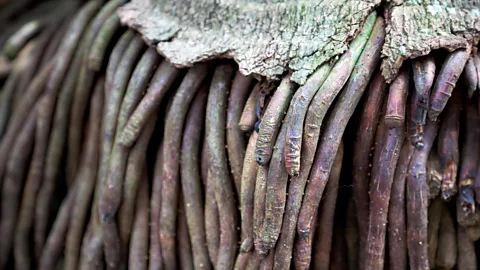 Alamy
AlamyThe evolution of roots transformed life on Earth – and understanding them could help us to grow more resilient plants.
More than 400 million years ago, in a patch of wafer-thin soil, a tiny plant did something revolutionary: it grew one of its branches downwards.
That adventurous branch, and those that followed, became the world's first roots – and they transformed life on Earth forever. Before, the closest thing plants had to roots were shallow, hairy runners providing some anchorage. But as roots evolved, their skills extended far beyond that. Plants gained a whole new set of superpowers, allowing them to forage for water and nutrients underground and use those resources to shoot up to tree-size, form underground alliances, channel formless bog into meandering streams and rivers, rework the soils and even change the atmosphere.
These activities still play out right under our noses, in forests and parks, vegetable patches and flower pots – but scientists and gardeners are only beginning to discover their full potential, and use them to grow more resilient plants.
"Roots are the kind of hidden half of plants that in many cases you don't know that much about, unless you've done some weeding," says Sandy Hetherington, a palaeobiologist at the University of Edinburgh, and a specialist in root evolution. And yet, "we can learn a huge amount from understanding plants more fundamentally. And many things we can see over the course of evolution are things that people can actually experience in their gardens."
Frozen in time
Hetherington and his colleagues made several breakthrough discoveries about roots thanks to their studies of the Rhynie chert, an exceptionally well-preserved 407-million-year-old deposit of fossils found near the village of Rhynie, Aberdeenshire, Scotland.
 artwork by Richard Bizley, bizleyart.com
artwork by Richard Bizley, bizleyart.comThe chert, or rock, captures a piece of an ecosystem on the cusp of a significant transformation, giving us "a frozen-in-time view of what this landscape would have been like", Hetherington says. There are no completely evolved roots in that fossilised ecosystem. But one plant in the chert, Asteroxylon mackiei, has a kind of work-in-progress root, something midway between a branch and a root. It grows downwards, but doesn't yet have the root cap that protects the tips of modern roots.
21st Century Gardening
From working with contaminated city soil to reconsidering weeds, pests and even lawns, gardening is changing as we adapt it to the realities of modern life. This series takes a look at the future of gardens in the 21st Century – and explores how it can be updated to fit with modern sensibilities and challenges, such as environmental awareness and pollution.
As this early root evolves and grows, it begins to conquer the rather barren, thin-soiled world around it. "There's this concept of the critical zone, the thin veneer on the surface of the Earth, where basically all life is," says Hetherington. "Roots are there, and they are engineering and absolutely transforming it."
In the millions of years that follow, ever more powerful roots knead the Earth's surface into shape, breaking up rocks, and holding the deepening soil together. The critical zone grows from only a couple of millimetres, to a couple of metres, and begins to teem with micro-organisms. Hetherington describes an emerging landscape of giant lycophytes, an ancient group of plants that has become relatively uncommon, towering over the fern-like ancestors of our modern garden plants.
And all this happened in the blink of an eye, in evolutionary . From the days of the Rhynie chert, about 407 million years ago, "we go forward maybe 20 million years or so, to about 380, 390 million years ago, and suddenly, we've got forests and trees. So the fossil record seems to indicate that this really was a time of explosion in plant forms," Hetherington says.
In fact, roots were such a good strategy that plants came up with them on at least two totally separate occasions, research by Hetherington and his colleagues has shown. Lycophytes – a group that includes the A. mackiei in the Rhynie chert, but also, the modern-day resurrection plant, which can survive being dried out – gradually developed roots. Seed plants, a group that includes most garden plants, later also developed them.
Today, the strategies and microbial alliances developed in that distant past still shape our world – and gardeners are using them to grow more productive, nutritious and resilient plants.
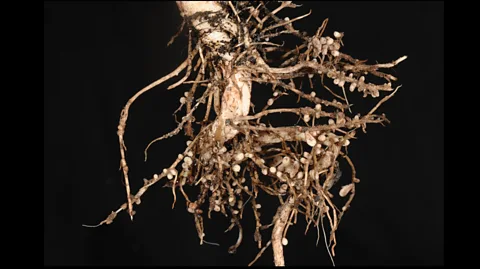 Alamy
AlamyUnlikely friends
In a hidden corner of the Royal Botanic Gardens at Kew in London, head kitchen gardener Hélèna Dove flips over a small plastic pot with a French bean plant, and reveals a tangle of white roots. Dotted between them are tiny, greyish-pinkish balls. One might easily mistake them for insect eggs, or beads of fertiliser. But they are actually homes for friendly bacteria, formed as part of a very old friendship.
You might also like:
Legumes – beans, peas, peanuts, chickpeas and clover, for example – form a symbiotic relationship with bacteria that can fix nitrogen from the air and turn it into ammonia, which the plant then converts into proteins and uses to grow, storing any excess in its leaves and seeds. Liquorice, the root traditionally used for sweets and syrups, is also a legume and has the same nitrogen-fixing powers.
In return, the plant houses the bacteria in root nodules – the mysterious tiny balls – and provides them with sugars and oxygen. (The nodules have a pinkish colour because the molecule that binds to the oxygen, called leghaemoglobin, is red, similar to the haemoglobin that carries oxygen in our own blood.)
That mutually beneficial relationship is about 60 million years old, according to Hetherington, who recommends looking for the nodules on the roots of clover when weeding, if you want to see them yourself.
Dove points out that this friendship plays a crucial part in global nutrition. "They're a really important crop for feeding the world," she says, carefully tucking the plant back into its pot. "Peas, beans, chickpeas, they get more protein because they have this relationship, so they're really good if you're having a plant-based diet. And that's why that relationship is really important." It also means legumes don't need nitrogen fertiliser.
Other ties are even older, such as the mycorrhizal symbiosis, the long and mutually beneficial association between plants and fungi that is formed by more than 85% of plant species. Like roots, fungi are only beginning to be more fully understood and appreciated.
"Because fungi live [mostly] below ground, usually they're out of sight, and we know very little about them," says Laura Suz, a mycologist at the Royal Botanic Gardens at Kew and Wakehurst who has studied their relationship with plants in different ecosystems. "Soil has been a big black box for many, many years."
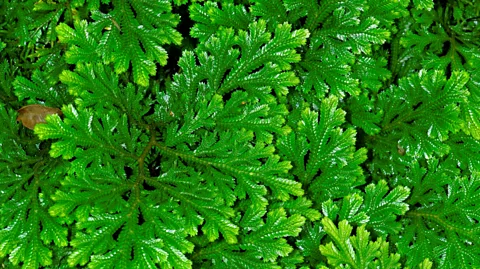 Alamy
AlamyPlants can form links with hundreds of species of fungi, research by Suz and her colleagues in the Alps has shown. "These fungi, compared to the roots, they are thinner and they are longer so they can get further from the roots, they can fuse, and they can get into very small pores, and reach nutrients that are not accessible for the plants. They can gather water from further distances, so they help with the resilience." This is especially important in harsh, low-nutrient environments, like high up in mountains in the Alps. "They also cover the very fine tips of the roots, so they act like a physical barrier for pests. So they really help them." In return, the plants give them sugars from photosynthesis.
Even in the average garden, where plants are thrown together from totally different habitats, they form communities with fungi, and also, with each other through the fungi connected to their roots. Broad bean plants use mycorrhizal networks for warfare, alerting each other of aphid attacks so the yet-unaffected plants can prepare defences. Plants even use such webs to poison the ground of competitors. Suz says the key factor is not necessarily whether plants evolved together, but whether they can link up with the same type of fungi – tapping into the same network to access nutrients. Plants as different as roses and grass can connect this way, she says.
So what's the secret of growing a root-and-fungi-powered garden? One solution is to step back in time – not millions of years, just a few centuries, to traditional communities that invented a surprisingly resilient and root-friendly way of gardening.
Resilient plants
Some of the world's most robust and long-lived gardens take lessons in root health from the forest, mimicking its composition of trees, shrubs and shade-tolerant ground plants. Gesturing towards her vegetable beds, and the immense botanic gardens beyond, Hélèna Dove explains: "If we just all disappeared, and didn't feed anything out there, the big perennial plants with the roots further down, they can find the food."
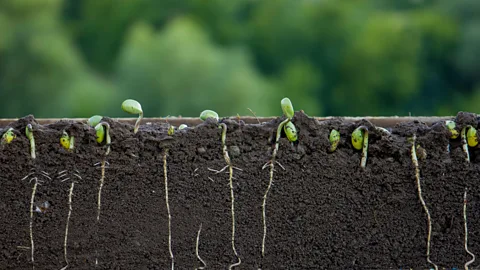 Alamy
AlamyRemnants of so-called forest gardens dating back millennia have been found in ancient Maya cities, where gardeners feasted on custard apples and pressed oil from the cohune palm. Centuries after they were abandoned, Maya forest gardens still maintained a live presence, sprouting a mix of cultivated plants that was different from the surrounding forest. Others are still nurtured by Maya forest gardeners today. (Read more about how some gardens have survived for centuries, even through long periods of neglect.)
In Canada, forest gardens planted by indigenous communities have been found to outlast their caretakers by more than 150 years, a study of archaeological village sites showed. Despite being surrounded by encroaching conifer forests, the sites still featured trees and shrubs typical of indigenous gardens, such as hazelnut, crabapple, elderberry and cranberry.
One major reason for the resilience of forest gardens is that they are sustained by a large network of living roots that can forage for water and nutrients deep underground, rather than being pulled up and resown every year. This leaves them less at the mercy of a gardener with a watering can. It also means the intricate soil architecture is not disturbed.
In recent years, forest gardens have been gaining in popularity among modern home gardeners. In mild climates, they can include up to seven layers, with chestnut, pear or apple trees at the top, and at the very bottom, edible roots, such as liquorice. In between, blackcurrant or gooseberry shrubs, ground-covering strawberries, sage, lemon balm or wild garlic, and climbing grapes or nasturtiums, reach for nutrients at different depths with their roots. A similar approach called agroforestry is being used increasingly in farming, by planting trees between crops, or in pastures.
Another root-friendly, soil-protecting gardening technique, which works for any type of garden, is the so-called "no-dig" approach, which Dove follows in the kitchen garden at Kew. It involves spreading out layers of mulch or compost on the surface, without digging it in.
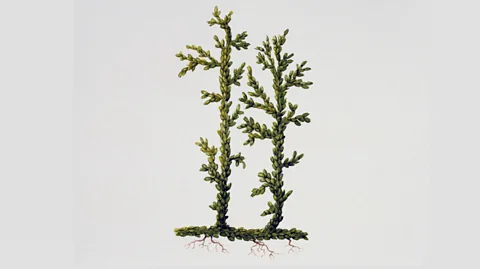 Alamy
Alamy"There are lots of organisms that have totally adapted to pull everything down," says Dove. "Worms spend absolutely ages making these beautiful wormholes, so there's lots of oxygen in the soil, and if you go through, you bash all that out. And there are lots of different kinds of worms, you've got guys at the top, guys in the middle and guys at the bottom. They're all organised! The more we do to the soil, the more we're wrecking their system."
Evolution in a pot
Perhaps surprisingly, not all roots like to roam free. Those that evolved to adapt to rocky landscapes with little soil, actually do well in a constrained setting that mimics this habitat, Dove says – such as a flower pot. When there is too much soil around them, they can't absorb all the moisture, the soil then becomes waterlogged, and the roots rot.
Dove shows me a row of potted trees and climbing plants, including a thriving green grapevine, and a flowering pomegranate tree. Both are happy to have their roots restricted, she says, which she puts down to the rocky habitat they evolved in. It's only when a potted plant's roots have started to circle around, or put out little rootlets above the surface, that she recommends moving on to a bigger pot, or pruning back the roots. Pruning restricts their top growth, and helps the plant stay a size that's suitable for the pot and available soil. Such root-restricted plants can still produce large fruit. Dove recounts how Kew's kitchen garden and the neighbouring bonsai collection once held a friendly pomegranate-growing competition. It was the much smaller bonsai tree, with heavily clipped roots, that grew the biggest pomegranate.
The key to providing that perfect habitat is to investigate the plant's evolutionary history, which as Dove points out, may be very different from how we see the plant now. For example, though now widely grown in cool climates, carrots are thought to have originated in Afghanistan, Iran and Pakistan, where they would have grown in hot weather and free-draining soil. Some of the heat-tolerant qualities of certain wild carrots may even help us develop varieties for a changing climate.
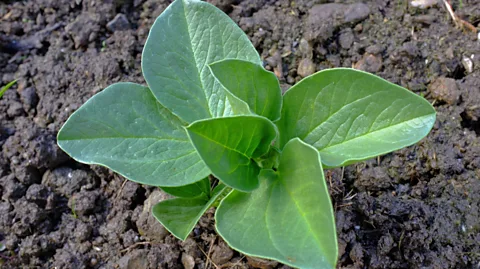 Alamy
Alamy"Carrots do really, really well in a pot," says Dove – as long as one gives space to its full-length root, which is much longer than the fleshy, central part and tapers down to a thin thread. At the bottom is a root cap, a device that protects the root and helps it explore the soil. This would have been advantageous for reaching deep water reserves in rocky ground, but can be a source of frustration for gardeners. If the root cap is snapped off or damaged, for example if a seedling is transplanted or if the root hits a stone, the carrot will become forked and misshapen. The solution, Dove says, is to choose a stumpy variety such as Paris Market, or Nantes, pick a pot that is about 5-10cm (two to four inches) longer than the final carrot, and sow the seeds directly into the pot. "We grow them in pots a lot, actually."
Root restriction could play an even more important part in the future: scientists have experimented with root restriction in sweet bell pepper plants as an option for growing food in outer space. The idea was to keep the plants small and light for spaceflight, while still producing juicy, vitamin-C-rich peppers, and it appeared to work. The restricted roots resulted in shorter plants with less canopy – a good thing in a cramped space station – while fruit production was not much affected. (Incidentally, astronauts succeeded in growing hot chile peppers onboard the International Space Station for the first time last year).
Hetherington has woven the long history of roots into his own everyday life. His shared office and garden are filled with plants with an interesting evolutionary history, such as ferns, lycophytes, and one of his favourites, the gingko tree, which has a history of about 200 million years.
And he still enjoys studying roots in all their diversity when tidying his patio, iring the deep tap root of a dandelion in search of water, or the matted, shallow roots of grass finding food closer to the surface: "It's something you will gain a bit of an appreciation of when you're weeding."
--
